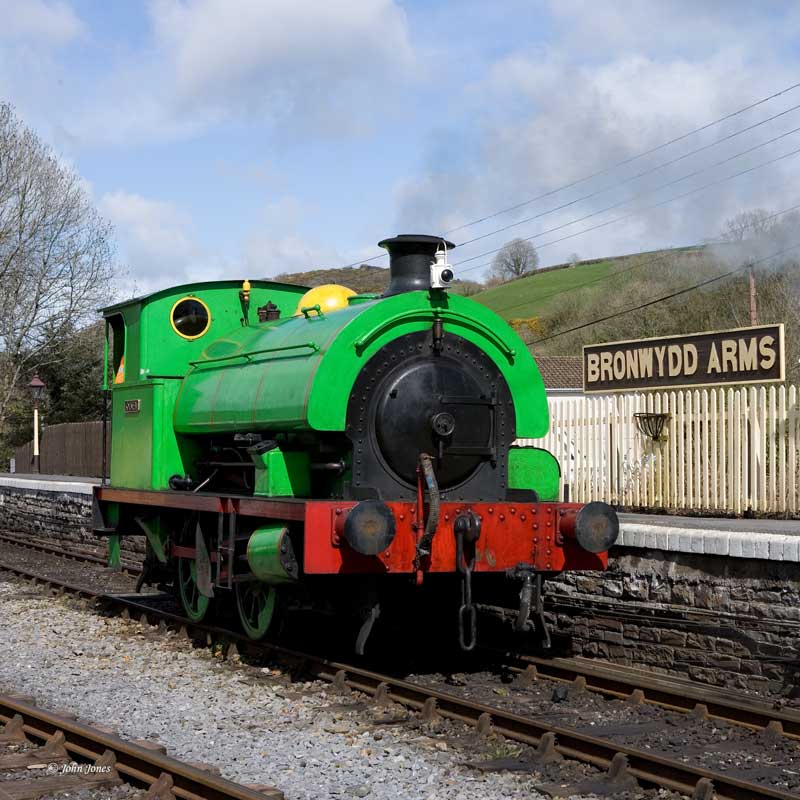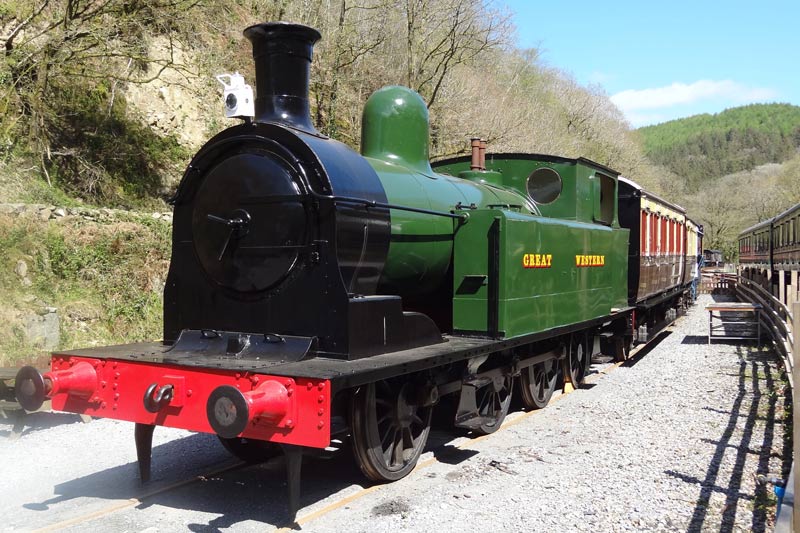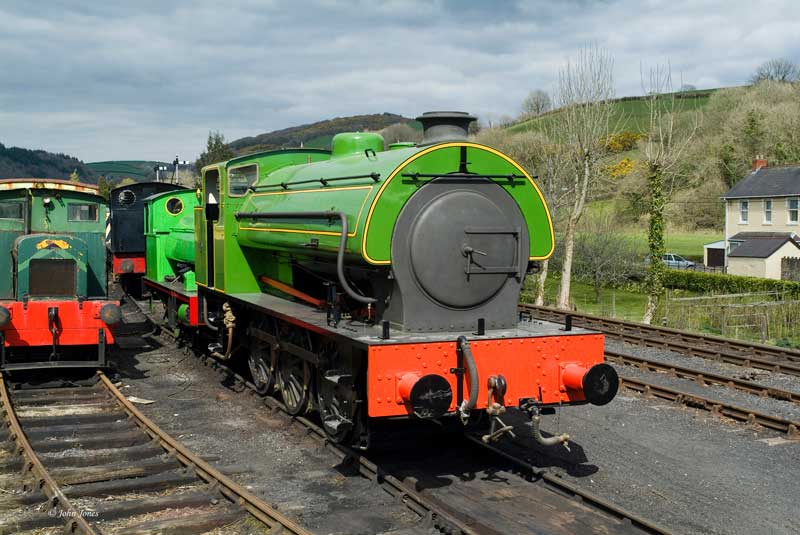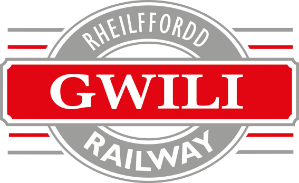Steam Locomotives
Our steam fleet comprises of both mainline and ex-industrial locomotives. The fleet is unique in that it encapsulates a century of industrial steam in South Wales, as many of our locomotives have operated in the region during their varied careers. Many passengers and fans in West Wales have requested some information about our locomotives. Here goes:
RSH No. 7849 Moorbarrow
Moorbarrow, was built by RSH in 1955 for use by the National Coal Board (Northumberland Area) at Backworth Colliery. Whilst working there, it wore a smart royal blue livery and carried the number ’47’. It subsequently moved to Whittle Colliery, before being sold into preservation in 1973.
It gained it’s name during a visit to the North Yorkshire Moors Railway: “Moorbarrow” is the fictitous name of Goathland Station in Pat Wilson’s books and plays.
“Moorbarrow” has led something of a peripatetic existence in preservation, having visited a number of different railways. It arrived at the Gwili Steam Railway in time to work in the 2015 Santa season. After 3 years excellent service on our line, it was withdrawn when its boiler certificate expired. It returned to service in 2021 and is now a bright, vibrant member of our operational locomotive fleet.


RSH 0-4-OST No.7058 (1942) Olwen
Originally worked at Earley Power Station near Reading, on its internal railway system. The locomotive is owned by the Gwili Railway Preservation Society who continue to raise money for its current overhaul.
The loco is currently on static display at Llwyfan Cerrig. Its bright green livery gives a clue to its useful role as a hire engine in the past.
01 Class 0-6-2T TVR No.28
Taff Vale Railway ’01’ Class 0-6-2 No.28 was built in 1897 at West Yard Works, Cardiff to a design by Tom Hurry Riches. It was designed to pull passengers and freight on lines in the South Wales and Cardiff Docks and represents one of a series of similar locomotive types that would influence the development of the GWRs 56xx class 0-6-2T.
No.28 was withdrawn from mainline service by the GWR in 1926. The locomotive saw further use with the Army and the National Coal Board, which enabled it to survive into preservation – becoming a part of the National Collection in 1960.
Briefly returning to working order in Caerphilly in the 1980s, No.28 was later moved to the Dean Forest railway in Gloucestershire after the group looking after it disbanded. It then moved to the Llangollen Railway in a dismantled state, where it was stored until the intervention of the Gwili Vintage Carriage Group under the leadership of Dewi Jones and James Buckley.

The Welsh Project was formed to raise money to re-assemble and cosmetically restore the locomotive and to return it as a display in Wales. This was the first step of a project to pair TVR No.28 with a collection of vintage carriages at the Gwili Steam Railway, including a ex-TVR No.220, a brake coach of 1881.
Now back in one piece after 17 years (sporting GWR livery for the first time since 1927). The locomotive returned temporarily to Cardiff in April 2014. In a move initiated by the Cardiff Civic Society and with the assistance of Cardiff Council and the ‘Brains Brewery’. TVR No.28 was displayed close to the site of West Yard Works where it was built whilst en-route to the Gwili Railway.
The Locomotive is now on loan to the Gwili Vintage carriage Group from the National Railway Museum in York.
Taff Vale locomotive number 28 is the only surviving member of the 01 Class. It is also the only surviving standard gauge locomotive designed and built in Wales. After service with the Taff Vale and Great Western Railways, it moved into military service and then onto the coalfields of County Durham before being retired. The locomotive now forms part of the national collection of historically important locomotives, owned by the National Railway Museum in York.
After restoration in Caerphilly in the 1980s and having work carried out at the Dean Forest and Llangollen Railways, number 28 is now based on the Gwili Railway. Work has now started on its conservation with a view to full restoration.
It is intended to return the locomotive to its original Taff Vale condition, but significant work is required on the boiler, tanks and bunker as well as replacing missing components. The team currently meets once a month at the Gwili Railway. Any help is greatly appreciated, if you would like to become involved in this interesting project please contact us on the number below.
Any financial donations can be made to the Gwili Vintage Carriage Group and will help us get number 28 in steam once more. We can be contacted through our Facebook page @gvcguk, email: [email protected] or by telephone: 07961 940651
Contact us at C/O Gwili Railway: Bronwydd Arms Station, Carmarthen. SA33 6HT

Peckett 0-4-OST No.1345 (1914) “Mond Nickel No.1”
This locomotive used to work at Clydach-On-Tawe Nickel Works.
It was restored in the preservation era at the Six Pit Works of the Swansea Vale Railway and subsequently moved to the Gwili Railway where it has been cosmetically restored into lined maroon livery. The locomotive is temporarily stabled out of public view.
No.3879 Haulwen
Haulwen is a Hunslet Austerity locomotive, built in 1942 as No.5272.
Constructed at the Vulcan Foundry in 1945, she initially worked as the Longmoor Military Railway (named Insein), before being transferred to the Woolmer Institutional Railway. Sold by the Army to Hunslet in 1959, she was sent to Hunslet Ltd. in 1961 to be rebuilt and renumbered as No.3879. It was then sold to the National Coal Board to work initially at Cambrian Colliery and then at Mountain Ash. The engine was placed on loan at the Caerphilly Railway Society in 1981 and was later bought by them.
The name Haulwen means “White Sunlight”, “Bright Sunlight” or “Bright Star” depending on the translation from Welsh and was the name of the Mountain Ash Colliery Manager’s Grandaughter.
Haulwen worked solidly at the Gwili Railway until 2015, when it was withdrawn for overhaul. The boiler has been dispatched for refurbishment, while the frames are in the loco shed at Bronwydd with work progressing steadily.


Hunslet No.3829
Was built in Leeds in 1955 and worked at NCB Lady Windsor. It was originally purchased for restoration at the Swansea Vale Railway where some work was carried out in the Upper Bank Works.
Now based at Gwili Railway it is currently stored on static display pending return to traffic.
